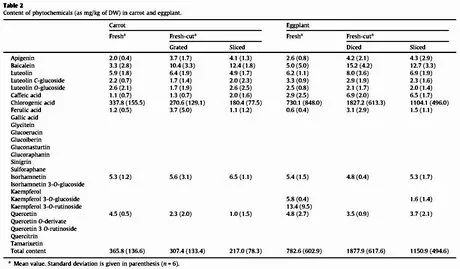 Scientists of Almeria University, Spain, have compared fresh produce with fresh-cut product for the phytochemicals content, especially for phenolic acids, isoflavones, flavones, flavonols and glucosinolates.
Scientists of Almeria University, Spain, have compared fresh produce with fresh-cut product for the phytochemicals content, especially for phenolic acids, isoflavones, flavones, flavonols and glucosinolates. Tomatoes, carrots, grape, eggplants and broccoli were tested for the comparison (Table 1 and 2).
Moreover, the scientists have investigated the effect of commercial presentation (sliced, diced, and grated vegetables) and storage conditions (temperature: 4 vs. 25 °C; light: lightness vs. darkness) on the phytochemicals content in carrot and eggplant.
Tab 1 - Click here to enlarge.

In the case of fresh-cut vegetables, the cutting typology affected significantly the phytochemicals content, especially phenolic acids, whose lower content was detected in sliced vegetables while higher content was detected in diced and granted vegetables.
Tab 2 - Click here to enlarge

During storage, the commercial presentation affected significantly the phenolic acids content in fresh-cut eggplant, while the phytochemicals content was higher in fresh-cut carrot stored at 4°C regardless of light conditions.
Tab 3 - Clicke here to enlarge

The scientists conclude that fresh produce and fresh-cut products have similar beneficial properties as regards the phytochemicals content, except for tomato, which should be consumed as fresh vegetable.
Source: Alarcón-Flores M.I., Romero-Gonzáles R., Martínez Vidal J.L., Egea González F.J., Garrido Frenich A., "Monitoring of phytochemicals in fresh and fresh-cut vegetables: A comparison", Food Chemistry, 2014, Vol. 142, pagg. 392-399. Further info: http://www.ncbi.nlm.nih.gov/pubmed/24001857
